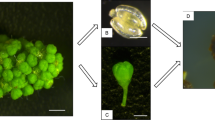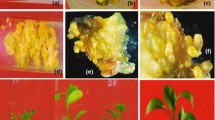Abstract
Resistance to the alfalfa weevil (Hypera postica (Gyllenhal)) and the potato leafhopper (Empoasco fabae (Harris)) is lacking in cultivated alfalfa. However, a closely related annual Medicago, Medicago scutellata, possesses dense glandular stem and leaf hairs which provides a mechanism for resistance. Several attempts have been made at transfering the glandular haired traint from M. scutellata to perennial alfalfa with limited success. Earlier studies have shown that one reason for the lack of success is embryo abortion. Therefore, this study was initiated to observe zygotic embryo-genesis and to develop an embryo rescue technique for M. scutellata and M. sativa. Observations of zygotic embryogenesis showed that the two species are similar in morphology and can be described from youngest to oldest as globular, heart, torpedo, and hook shaped embryos. M. sativa embryos are smaller than M. scutellata embryos and develop three to four days later. Self pollinated M. scutellata (PI 307446) and sib mated M. sativa (Saranac AR) embryos were cultivated on Murashige and (2,4-D), indolacetic acid (IAA), 6-benzylaminopurine (BAP), and kinetic (KIN). Embryos from both species were also cultured on Schenk and Hildebrandt's (SH) basal medium with the addition of L-glutamine and L-proline. The experimental design was a completely randomized factorial for each experiment. Heart and torpedo shaped embryos from M. scutellata grew best (27.5% plantlet recovery) when cultured on MS medium with 0.05 mgl-1 of both IAA and BAP. After 15 to 30 days on this medium, the embryos had only developed shoots. Therefore, it was necessary to transfer the shoots to MS basal medium without phytohormones for rooting. Rooting occurred in 15 to 30 days and the plantlets could be acclimatized to soil within 2 to 4 weeks. M. sativa embryos grew best (31% plantlet recovery) on SH medium with 50 mM L-glutamine. M. sativa embryos developed both shoots and roots on this medium. This information may now be applied to the development of an embryo culture method for recovering insect resistant hybrids between M. scutellata and M. sativa.
Similar content being viewed by others
References
Bajaj YPS, Kumar P, Sing MM, Labana KS (1982) Interspecific hybridization in the genus Arachis through embryo culture. Euphytica 31: 365–370
Barnes DK, Ratcliffe RH (1969) Evaluation of annual species of Medicago as sources of alfalfa weevil resistance. Crop Sci 9: 640–642
Bauchan GR, Elgin JH (1984) A new chromosome number for the genus Medicago. Crop Sci 24: 193–195
Blaydes DF (1966) Interaction of kinetin and various inhibitors in the growth of soybean tissue. Physiol Plant 19: 748–753
Cooper DC (1935) Macrosporogenesis and embryology of Medicago. J Agr Res 51: 471–477
Elgin JH, McMurtry JE, Schaeffer GW (1977) Attempted interspecific hybridization of Medicago scutellata and M. sativa. Agron Abst pg. 54
Fridricksson S, Bolton JL (1963) Development of the embryo of Medicago sativa after normal fertilization and after pollination by other species of Medicago. Can J Bot 41: 23–33
Gosal SS, Bajaj YPS (1983) Interspecific hybridization between Vigna mungo and V. radiata through embryo culture. Euphytica 32: 129–137
Grant WF, Bullen MR, deNettancourt D (1962) The cytogenetics of Lotus. I. Embryo-cultured interspecific diploid hybrids closely related to L. corniculatus. Can J Genet Cytol 4: 105–128
Linsmaier EM, Skoog F (1965) Organic growth factor requirements of tobacco tissue cultures. Physiol Plant 18: 100–127
McCoy TJ, (1985) Interspecific hybridization of Medicago sativa L. and M. rupestris MB. using ovule-embryo culture. Can J Genet Cytol 27: 238–245.
McCoy TJ, Smith LY (1986) Interspecific hybridization of perennial Medicago species using ovule-embryo culture culture. Theor Appl Genet 71: 772–783
Murashige T, Skoog F (1962) A revised medium for rapid growth and bioassay with tobacco tissue cultures. Physiol Plant 15: 473–497
Newell CA, Hymowitz T (1982) Successful wide hybridization between the soybean and a wild perennial relative. Glycine tomentella Hayata. Crop Sci 22: 1062–1065
Oldemeyer RK (1956) Interspecific hybridization in Medicago. Agron J 48: 584–585
Pecket RC Selim ARAA (1965) Embryo culture in Lathyrus. J Exp Bot 16: 325–328
Phillips GC, Collins GB (1979) In vitro culture of selected legumes and plant regeneration from callus of red clover. Crop Sci 19: 59–64
Phillips GC, Collins GB, Taylor NL (1982) Interspecific hybridization of red clover (Trifolium pratense L) with T. sarasiense Hanzsl. using in vitro embryo rescue. Theor Appl Genet 62: 17–24
Sangduen N, Sorensen EL, Laing GH (1982) A perennial X annual Medicago cross. Can J Genet Cytol 24: 361–365
Sangduen N, Sorensen EL, Laing GH (1983) Pollen germination and pollen tube growth following self-pollination and intra- and interspecific pollination of Medicago species. Euphytica 32: 527–534
Sangduen N, Kreitner GL, Sorensen EL (1983) Light and electron microscopy of embryo development in perennial and annual Medicago species. Can J Bot 61: 837–849
Schenk RU, Hildebrandt HC (1972) Medium and techniques for induction and growth of monocotyledonous and dicotyledonous plant cell culture. Can J Bot 50: 199–204
Shade RE, Doskocil MJ, Maxon ND (1979) Potato leafhopper resistance in glandularhaired alfalfa species. Crop Sci 19: 287–288
Shade RE, Thompson TE, Campbell WR (1975) An alfalfa weevil larval resistance mechanism detected in Medicago. J Econ Entomol 8: 399–404
Stuart DA and Strickland SG (1984) Somatic embryogenesis from cell cultures of Medicago sativa L. I. The role of amino acid additions to the regeneration medium. Pl Sci Let 34: 165–174
Webster GT (1955) Interspecific hybridization of Melilotus alba x M. officinalis embryo culture. Agron J 47: 138–142
Williams EG, deLautour G (1981) Production of tetraploid hybrids between Ornithopus pinnatus and O. sativus using embryo culture. N Z J Bot 19: 23–30
Author information
Authors and Affiliations
Additional information
Disclaimer statement: Mention of a trademark or proprietary product does not constitute a guarantee or warranty of the product by the USDA, and does not imply its approval to the exclusion of other products that may also be suitable.
Rights and permissions
About this article
Cite this article
Bauchan, G.R. Embryo culture of Medicago scutellata and M. sativa . Plant Cell Tiss Organ Cult 10, 21–29 (1987). https://doi.org/10.1007/BF00037493
Received:
Accepted:
Issue Date:
DOI: https://doi.org/10.1007/BF00037493




